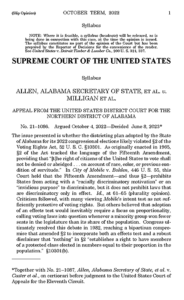August 5, 2023
Allen v. Milligan, 599 U.S. ___, No. 21-1086 (2023) (Roberts, C.J.)
Response by Peyton McCrary
Geo. Wash. L. Rev. On the Docket (Oct. Term 2022)
Slip Opinion | SCOTUSblog
The Surprising Success of the Alabama Plaintiffs in the Voting Rights Case Allen v. Milligan
In the recent Supreme Court term, the conservative majority on the Court prevailed on a significant number of controversial decisions.1 In the area of minority voting rights, however, the Court surprised experienced observers by ruling in favor of Alabama minority plaintiffs in a major redistricting case, Allen v. Milligan.2 Chief Justice John Roberts delivered the opinion of the Court in Milligan, upholding the precedents for enforcing Section 2 of the Voting Rights Act that have guided the federal courts for almost four decades.3
The congressional redistricting plan adopted by Alabama following the 2020 census included only one district in which Blacks constituted a voting-age majority—as had been true for every decade in Alabama, beginning with the 1990s.4 Plaintiffs persuaded the Court, however, that two such districts could be readily drawn using current census data for Alabama, consistent with traditional redistricting principles and with the “totality of circumstances” test of Section 2.5 The resulting majority opinion faithfully applies the framework developed in the Court’s 1986 decision in Thornburg v. Gingles.6
As the Milligan Court notes, Congress amended Section 2 of the Act in 1982 to create a statutory route around the constitutional intent requirement established two years earlier by another Alabama decision, City of Mobile v. Bolden.7 Before 1982, all vote dilution cases—whether involving the use of at-large elections or redistricting plans—were decided under the Fourteenth Amendment.8 After Congress amended Section 2, minority plaintiffs (and the Department of Justice) ordinarily utilized the statutory route—especially after the Gingles decision.9
The heart of the current Milligan case, in the view of the majority, is “Alabama’s attempt to remake our Section 2 jurisprudence anew,” focusing on the first of the three Gingles “preconditions,” the requirement for plaintiffs to construct an illustrative majority-minority district to show that a remedy for the violation is possible.10 Alabama contends that this precondition “ends up requiring racial proportionality in districting.”11 To avoid this, Alabama argues, plaintiffs would have to show that the illustrative plan “cannot have been ‘based’ on race” by utilizing modern computer technology generating large numbers of districting maps without considering race—“maps that were ‘race-blind’”—to create a “race-neutral benchmark.”12 The majority finds “Alabama’s new approach to § 2 compelling neither in theory nor in practice,” and thus it declines “to recast our § 2 case law as Alabama requests.”13
Since 1986, the first Gingles precondition obliges plaintiffs to show that an alternative districting plan could provide effective minority representation by drawing a new majority-minority district.14 In short, the Court’s first precondition requires plaintiffs to take race into account in drawing an “illustrative” district, but balances that against requiring proof that voting patterns are racially polarized such that the majority group is “usually” able to defeat the minority-preferred candidate.15 The court will then take into account the “totality of circumstances” in which the election plan operates.16
Justice Kavanaugh concurred in the majority opinion on the key points discussed above, but not in Part III-B-1—that section of the Court’s opinion thus only has plurality support. In Part III-B-1, the Court addresses “how the race-neutral benchmark would operate in practice.”17 In that portion of the opinion, the Court addressed many of the arguments of the dissents authored by Justices Thomas and Alito. This section of the opinion exposes some of the conflicting views within the membership to the current Court—and will necessarily be of interest to court-watchers—but does not provide clear guidance for the lower courts as to how future voting rights challenges should be addressed.
In short, other than speculations about how to interpret both Section III-B-1 and the lengthy dissents by Justices Thomas and Alito, the majority opinion in this case supports a continuation of that way parties have addressed Section 2 challenges to dilutive voting practices over the last four decades.
Given a chance on remand to draw a plan in compliance with Section 2, the Alabama legislature defiantly drew a revised redistricting plan that once again provided only a single majority minority district.18 The trial court will now appoint a special master to draw a remedial plan that complies with Section 2, in accordance with the Supreme Court’s decision.19
Peyton McCrary is a Professorial Lecturer in Law, George Washington University Law School, where he has taught voting rights law for 15 years. From 1990 through 2016, he served as a social scientist in the Civil Rights Division of the United States Department of Justice, working on voting rights litigation. His work on voting rights began in 1980 with two Alabama cases on remand from the Supreme Court’s decision in City of Mobile v. Bolden, 446 U.S. 55 (1980).
Recommended Citation
Peyton McCrary, Response, Allen v. Milligan, Geo. Wash. L. Rev. On the Docket (August 5, 2023), https://www.gwlr.org/the-surprising-success-of-the-alabama-plaintiffs-in-the-voting-rights-case-allen-v-milligan.

